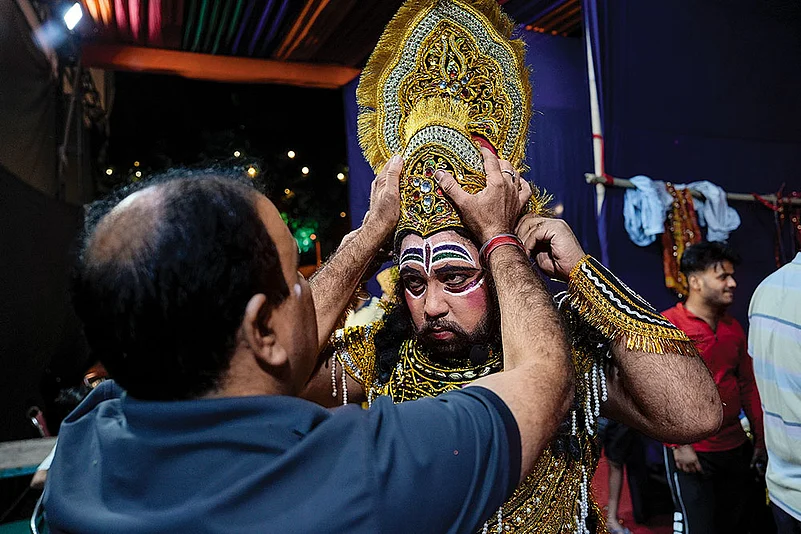This story was published as part of Outlook's 21 October 2024 magazine issue titled 'Raavan Leela'. To read more stories from the issue, click here
How does one become the other who embodies evil? Does the actor empathise with the one who was vanquished and has been remembered as the enemy of god? If Ramayana is a story of Ram, it can’t be the story of Raavan, and those who have come on stage to enact the king who abducted Sita perhaps know that the legacy of Raavan extends more than what a stage or a performance can hold. There was wisdom in the one hailed as a demon king. There is no good or bad. There are characters who aren’t black or white like the costumes or the exaggerated makeup. This is no morality play. To play him, you have to set aside the narrative of good over bad. That’s why people cry when Raavan dies, an actor who plays Raavan in Ram Leela, says.
‘Shri Ram’ is a dance drama version of the Ram Leela performed by the Shriram Bharatiya Kala Kendra in Delhi. The show has been going on for the past 68 years. Veteran Kathak dancer and actor Ghanshyam Khichi hails from a family of dancers and has been a part of Shriram Bharatiya Kala Kendra for the last 40 years. He began by playing the role of Vishwamitra but quickly progressed to Dashrath and then Hanuman. Eventually, he started playing the role of Raavan and has been doing so for the last 20 years. “Raavan’s father was a Brahmin and his mother was an Asura, so he had both their powers. He was a wise pundit and was a learned man. Every year, members of the audience come to me with tears in their eyes after the performance and say that they want to touch Raavan’s feet,” says Khichi.
Pankaj Handa’s family has also been involved in Ram Leela performances in Pul Pehladpur, near Faridabad, though in a purely amateur fashion. This style of production is typical of thousands of Ram Leelas put up in neighbourhoods all across north and central India, with amateur actors in chintzy costumes mouthing lines from the play to spellbound and devoted audiences every night during the Navaratri period. Handa belongs to a religious family that has been involved in the production for purely devotional reasons, though he admits to enjoying his time on stage. When he was nine years old, he played his first role—that of the deer that sent to entice Sita. He worked his way up to perform the role of Raavan in 2018. He says his physique and loud voice may have landed him the role. Handa sees great heroism in Raavan’s actions.
“After Lord Ram took on the avatar of Vishnu to kill him, Raavan knew it was his path towards mukti (fulfillment). Though he abducted Sita, he did not even touch her. He was a wise and brave man,” says Handa.
Text and photographs: Vikram Sharma

When he was nine years old, Pankaj Handa played his first role—that of the deer that sent to entice Sita.

Pankaj Handa’s family has also been involved in Ram Leela performances in Pul Pehladpur, near Faridabad, though in a purely amateur fashion.



Veteran Kathak dancer and actor Ghanshyam Khichi hails from a family of dancers and has been a part of Shriram Bharatiya Kala Kendra for the last 40 years. He began by playing the role of Vishwamitra but quickly progressed to Dashrath and then Hanuman. Eventually, he started playing the role of Raavan and has been doing so for the last 20 years.
(This appeared in the print as 'Being Raavan')


















